The Kyma International Sound Symposium is a place to share ideas, experiences and results with fellow Kyma practitioners in a relaxed, fun, and stimulating environment.
The second annual Kyma International Sound Symposium was held 24-26 September 2010 in the
in Vienna, Austria.
2010 was three days packed with music, technology, philosophical discussions, and Kyma master classes.
| Friday, September 24, 2010 |
|---|
| |
| 10.30 | Registration | |
|---|
| 11.00 | Bruno Liberda and Peter Rantasa | Welcome Message View Video
|
| 11.05 | Carla Scaletti | Keynote talk: Music is not a language: Non-symbolic meaning in sound View Video |
| 12.20 | Cristian Vogel | Zencoded. What’s inside a sound that has no meaning? View Video
People expect listening to be more than listening and so sometimes they speak of inner listening or the meaning of sound. When I talk about music it finally comes to people's minds that I am talking about sound that doesn’t mean anything… I love sounds just as they are and I have no need for them to be anything more than what they are. |
| 13.00 | Lunch | View Video |
|---|
| 15.00 | Carla Scaletti | What's new in Kyma View Video
Additions and enhancements to Kyma since KISS 2009, plus sneak preview |
| 15.35 | Hector Bravo Benard | The role of symbols and representation in musical creation View Video
Systems of representation and the flow of information in music. The role of notation in different styles of contemporary musical practice. |
| 16.20 | Coffee break | |
|---|
| 16.40 | Scott Miller | Constructing realities with Kyma View Video
Scott Miller will present an overview of Nelson Goodman’s theory of expression, which demonstrates how the arts express something when they metaphorically exemplify it. He will address issues such as how sound can function as a symbol system, the acousmatic vs. the mimetic in aesthetic expression, and analytical and creative applications of this symbol theory in electroacoustic music. This will include a performance of “Whispering Beast.” |
| 17.30 | John Paul Jones | Keynote performance: Music from Nearly Ninety Performance Interview
 Commissioned in 2009 by choreographer Merce Cunningham as part of his new dance piece in celebration of his 90th birthday, Nearly Ninety was premiered in New York at the Brooklyn Academy of Music in April 2009. This performance is of an abbreviated version of the original piece, lasting nearly 20 (instead of nearly 90) minutes. You can see a full performance featuring Merce Cunningham's Dance Company and live music from Takehisa Kosugi, John Paul Jones and Neokarma Jooklo Experience at the Barbican in London in October 2010. Commissioned in 2009 by choreographer Merce Cunningham as part of his new dance piece in celebration of his 90th birthday, Nearly Ninety was premiered in New York at the Brooklyn Academy of Music in April 2009. This performance is of an abbreviated version of the original piece, lasting nearly 20 (instead of nearly 90) minutes. You can see a full performance featuring Merce Cunningham's Dance Company and live music from Takehisa Kosugi, John Paul Jones and Neokarma Jooklo Experience at the Barbican in London in October 2010.
This performance is dedicated to the memory of Merce Cunningham.
|
| |
| 20.00 | | Evening reception
We meet in a typical Viennese location for a get together & dinner. |
| |
| Saturday, September 25, 2010 |
|---|
| |
| 10.00 | Hannes Raffaseder & Julian Rubisch | GEMMA (generative music for media application) The computer as realtime movie sound orchestra
How can algorithmic and generative composition methods from the field of experimental New Music be transferred to the applied sector of media production? A software tool is going to be developed, which is meant to simplify selection and production of media music by an optimized user interface as well as (partially) automated composition without the need for profound musicologist know-how. |
| 11.10 | David Moss | An alternative method of controlling symbolic sounds in performance View Video
A presentation on an alternative use for the Wiimote and OSCulator combination to control Kyma sounds. An explanation of how the Wiimote's infrared camera can be used to track multiple IR LEDs, which can be turned into controllers for Kyma using OSCulator. This enables me to explore a large range of motion for controlling Kyma sounds. |
| 11.35 | Coffee break | |
|---|
| 11.55 | Steve Everett | Auditory roughness and ecological listening in electro-acoustic music View Video
Examining the perceptual conditions for determining musical meaning in electro-acoustic compositions |
| 12.30 | Jim Brashear | Excitable speech View Video
An attempt to foster a potential relationship between two producers of symbolic languages of sound: Kyma and the human voice. |
| 13.00 | Lunch | |
|---|
| 15.00 | Brian Belet & Stephen Ruppenthal | System of shadows. A non-semantic dialogue and interactive performance environment for trumpet/flugelhorn and Kyma
This presentation focuses on the gestural and abstract performance lexicon that fuses System of Shadows, and positions the work securely within the realm of real-time non-semantic dialog and symbolic interchange. |
| 15.50 | Lowell Pickett | The Pentagon – an experiment using Kyma for live 3D audio manipulation in the music venue of the future View Video
The purpose of 'The Pentagon' is to present a new type of performance space that provides the audience with a unique social and musical experience in surround sound. The performer is positioned at the center of The Pentagon (in the middle of the audience) and uses Kyma to spatially mix and manipulate audio - alternatively, an assortment of performers can be positioned around the edges of The Pentagon. This experiment aims to heighten the audience's awareness of the real and virtual space around them. |
| 16.20 | Coffee break | |
|---|
| 16.50 | Peter Rantasa | Keynote talk: Decrypting Symbolic Sound: Preliminaries for a new aesthetics of listening View Video |
| |
| 20.00 | Evening Concert | |
|---|
| | Carla Scaletti | Autocatalysis for Kyma and Live Audience View Video
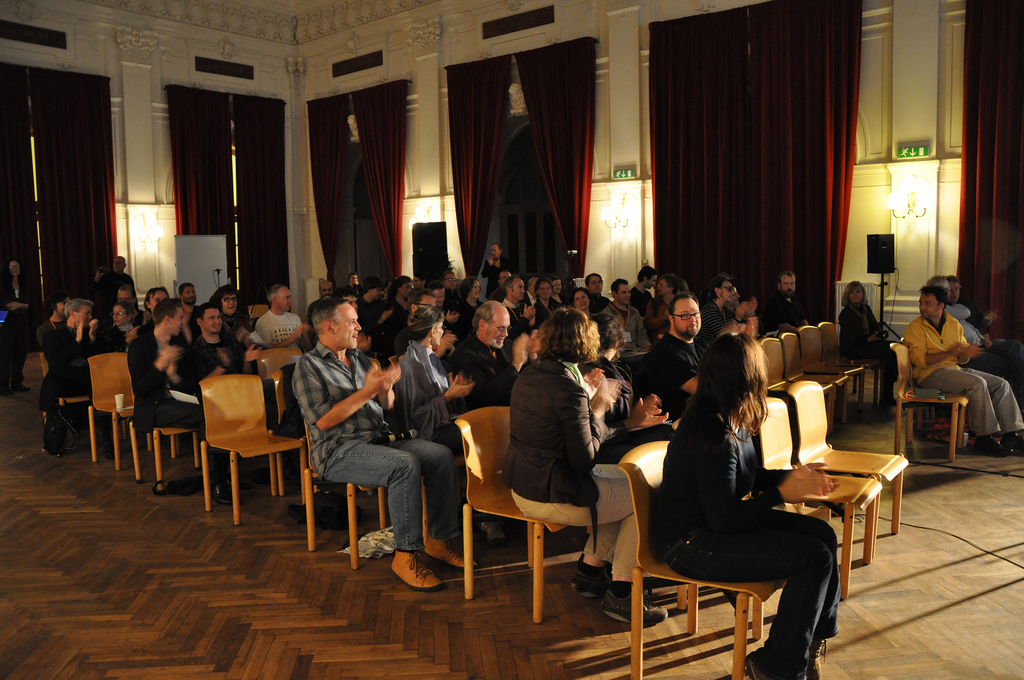 Nothing happens without your input. When you contribute input into the complex system, the results can sometimes inspire and energize you to create even more input. Create, listen, then respond. Nothing happens without your input. When you contribute input into the complex system, the results can sometimes inspire and energize you to create even more input. Create, listen, then respond.
A chemical reaction is said to be autocatalytic if the product of the reaction is itself a catalyst for that reaction. What keeps the process from blowing up is the rapid consumption of the initial reactants. The nonlinearilty of autocatalytic reactions sometimes results in the spontaneous generation of temporal and spatial patterns.
This piece creates auditory autocatalytic reactions using a Brusselator model (where the audience controls the levels of the chemicals) and dynamically-damped audio feedback. You, the audience, are collectively the performer.
This piece is dedicated to my father.
|
| | Andrea Young | Insatisfecha for voice and Kyma View Video
Andrea Young, voice & electronics
This piece was inspired by a poem written by the Chinese poet Huang O in the early 16th century. The attitude of the Chinese Government towards erotic literature was unusually lenient during this period, when many erotic novels were written and suggestive comedies performed. Regardless of the leniency during this time, it was still considered inappropriate for women writers. After translating this poem into Spanish, the text is used as a basis for improvisation with live electronics. The vocal processing is controlled by the voice and Wacom tablet, as pieces of this improvisation are recorded, processed further and tossed into a blender of rhythmic cacophony. This piece has been renewed several times in the course of its existence due to the comedic nature of the text and the pleasure of reinventing the vocal processing.
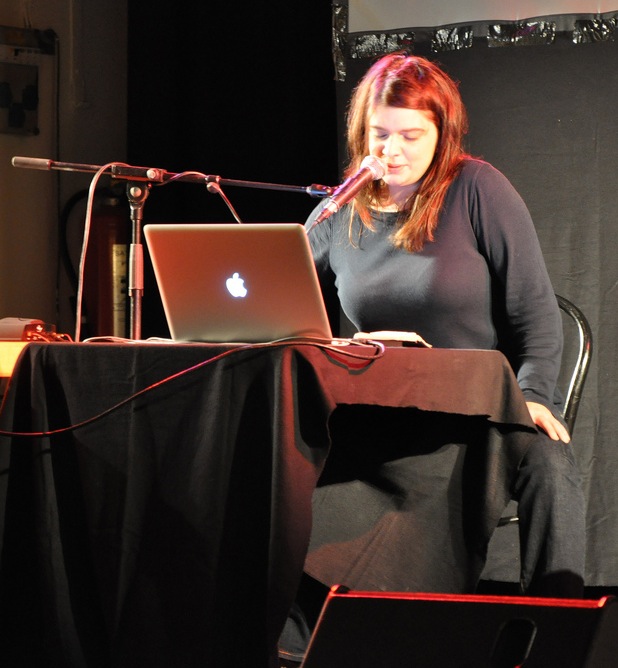 An English translation from Chinese by Kenneth Rexroth and Ling Chung: An English translation from Chinese by Kenneth Rexroth and Ling Chung:
If you don't know how, why pretend?
Maybe you can fool some girls,
But you can't fool Heaven.
I dreamed you'd play with the
Locust blossom under my green jacket,
Like a eunuch with a courtesan.
But lo and behold
All you can do is mumble.
You've made me all wet and slippery,
But no matter how hard you try
Nothing happens. So stop.
Go and make somebody else
Unsatisfied.
|
| | Brian Belet | System of Shadows for trumpet/flügelhorn and Kyma
Brian Belet, live electronics; Stephen Ruppenthal, trumpet/flügelhorn
1. Aurora Borealis 2. Andromeda’s Dream 3. Zephyr Apparition
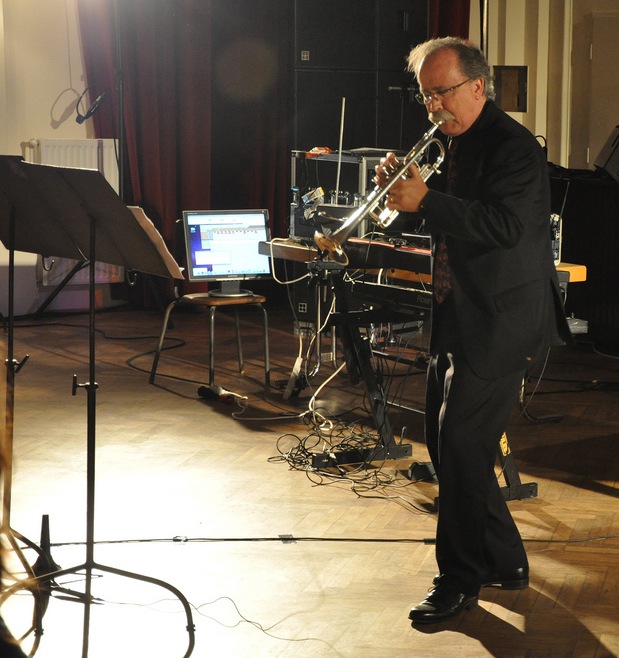 System of Shadows was composed in close collaboration with performer/sound poet/composer Stephen Ruppenthal, and the work is dedicated to him. The music environment is an interactive field for the live performer and Kyma. The trumpet music is fully notated through the three movements, with the invitation for the performer to improvise and otherwise comment on the music as the performance unfolds. All of the computer music is live processed trumpet within Kyma: various algorithms generate a unique sonic layer with each performance. The collaborative composing process is therefore reflected and reinterpreted during each collaborative performance. System of Shadows was composed in close collaboration with performer/sound poet/composer Stephen Ruppenthal, and the work is dedicated to him. The music environment is an interactive field for the live performer and Kyma. The trumpet music is fully notated through the three movements, with the invitation for the performer to improvise and otherwise comment on the music as the performance unfolds. All of the computer music is live processed trumpet within Kyma: various algorithms generate a unique sonic layer with each performance. The collaborative composing process is therefore reflected and reinterpreted during each collaborative performance.
The ‘shadow’ imagery operates both as a systematic process between trumpet and computer (and between computer and trumpet) and as a symbolic metaphor. The two sound sources shadow each other in a variety of ways, including reflection, variation, anticipation, and commentary. I find that shadows, in their own way, illuminate what they otherwise obscure in unexpected and often revelatory ways. The subtleties of the northern aurora cannot be clearly seen straight on; yet glancing aside into the deeper shadows of the night sky reveal the shimmering curtains and colorful ionized trails. Dreams, apparitions, and phantoms also point to those shadowy premonitions and after images we experience during moments of insight.
|
| |
| | Intermission | View Video |
|---|
| | Avi Benjamin | Soundtracks for movies that don’t yet exist: Die Taubheit View Video1 View Video2
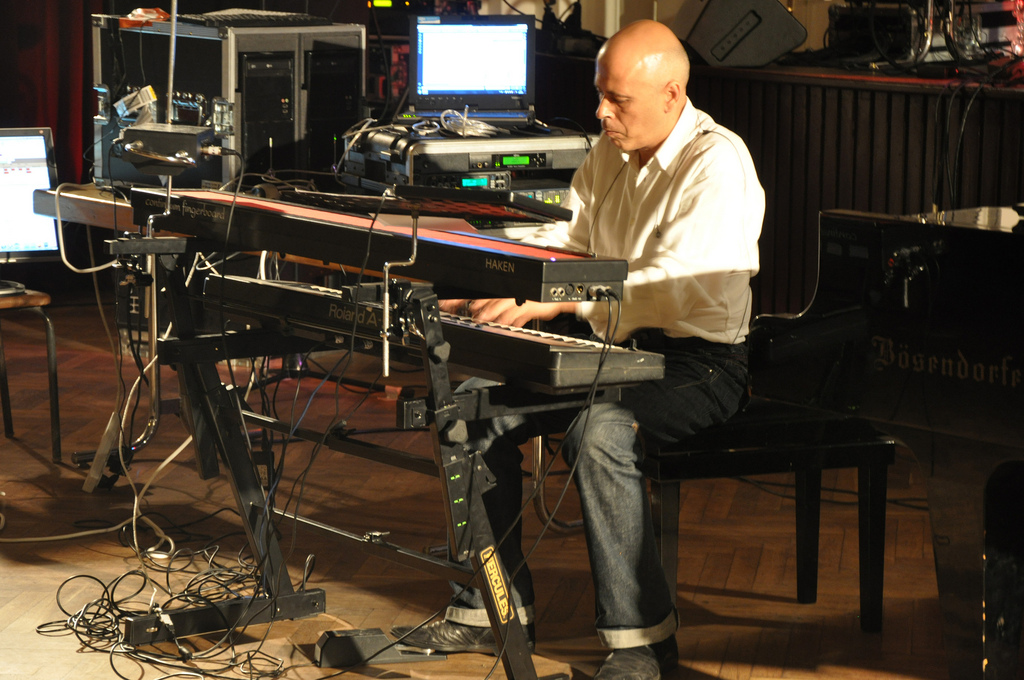 Avi Benjamin, piano and live electronics Avi Benjamin, piano and live electronics
The idea was to show how Kyma can change not only timbre palette of Beethoven's sonata, but let you also "play" with harmony, rhythmic structures etc. Which means that it is possible to change the whole idea of Beethoven's piano sonata. I want to point out that I'm speaking about live performance, not prerecorded stuff. For example, the first part of my Beethoven's triptych is the last piano sonata first part, that I play on digital piano from the beginning to the end (with earphones). But audience hear not only "clean" Beethoven, but also live electronic processes.
|
| | Hector Bravo Benard | Circles View Video
Hector Bravo Benard, percussion and live electronics
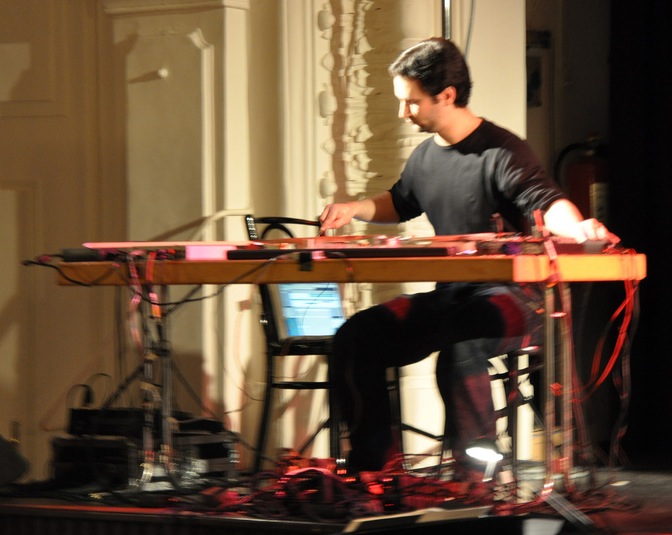 The plates are excited by scraping, bowing and hitting them with different objects. The tam-tam is also played through the use of contact microphones. Their amplified sound is played back by a transducer through the plate, creating a feedback loop which is filtered by the resonances of the plate itself, and controlled by the processing network in Kyma. The plate is thus used as both instrument and speaker, blurring the line between what is acoustic and what is electronic. The plate is not just the instrument, and the microphone is not just something that picks up its sound. Instead, the plate is now also recognized as a filter and a speaker, and the contact microphone as a kind of electronic bow. Technology is thus used to transcend the old symbology of instruments, microphones and speakers, and forces us to interpret each element as part of a network where the roles of the elements are not so strictly defined as in traditional music (both instrumental and electronic), and where the symbols cannot be separated individually from the entire phenomenon of sound production/processing without also losing their own meaning. The plates are excited by scraping, bowing and hitting them with different objects. The tam-tam is also played through the use of contact microphones. Their amplified sound is played back by a transducer through the plate, creating a feedback loop which is filtered by the resonances of the plate itself, and controlled by the processing network in Kyma. The plate is thus used as both instrument and speaker, blurring the line between what is acoustic and what is electronic. The plate is not just the instrument, and the microphone is not just something that picks up its sound. Instead, the plate is now also recognized as a filter and a speaker, and the contact microphone as a kind of electronic bow. Technology is thus used to transcend the old symbology of instruments, microphones and speakers, and forces us to interpret each element as part of a network where the roles of the elements are not so strictly defined as in traditional music (both instrumental and electronic), and where the symbols cannot be separated individually from the entire phenomenon of sound production/processing without also losing their own meaning.
|
| | Bruno Liberda | a sphere of air is bound for wind instrument(s) & electronics View Video
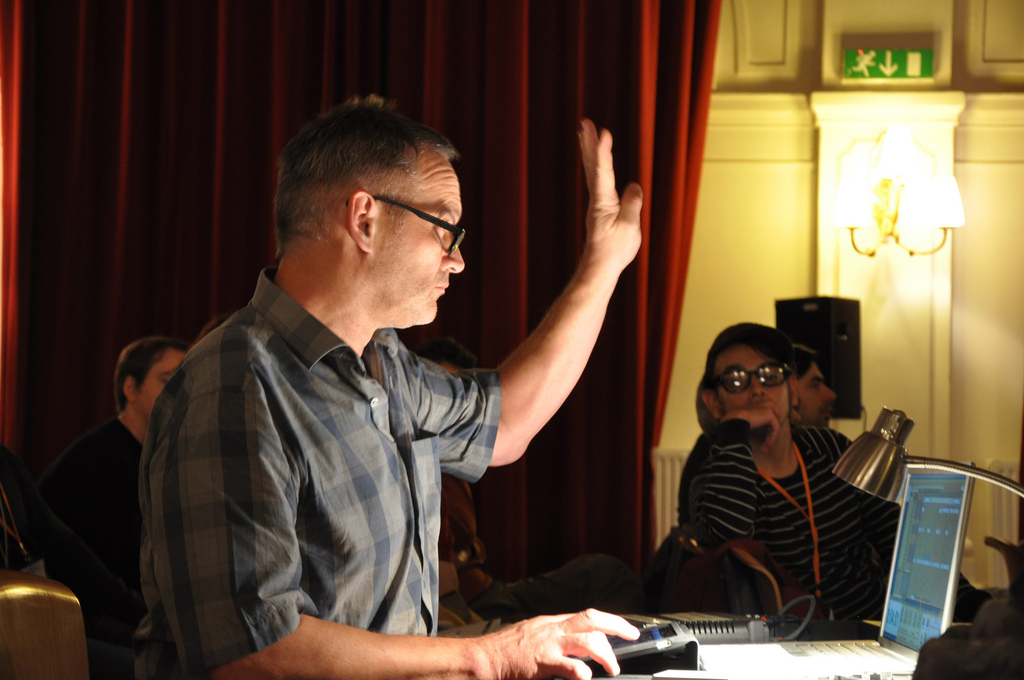 Bruno Liberda, live electronics; Stephen Ruppenthal, trumpet Bruno Liberda, live electronics; Stephen Ruppenthal, trumpet
"... Start from the most basic steps – namely the selection and processing of the material. The first thing was to choose the right kind of bamboo as material for the weaving. The tough texture of four-to-five-year-old Phyllostachys pubescens, for example, is ideal for making furniture, while the softer texture of three-year-old Phyllostachys makinoi Hayata is easier to weave into a basket. Once the kind of bamboo is selected, it is then "cooked" in soda water to remove the plant's oils, and after that it is ready to be stripped to desired sizes. The stripping is a process that determines the results of the final products. Bamboo weaving is a time-consuming craft, and there is always the chance of making a wrong move that causes one to have to undo ones work and start all over again."
|
| |
| Sunday, September 26, 2010 |
|---|
| |
| 10.00 | Carla Scaletti | Kyma Masterclass Part 1
Introduction to Kyma, Parameter Control & Composing with Sounds |
| 13.00 | Lunch | |
|---|
| 14.00 | Carla Scaletti | Kyma Masterclass, continued Part 2 Part 3
CapyTalk, Sound Design Problems & Solutions, Dissecting Autocatalysis |
| 17.00 | End Masterclass | |
|---|
| |
| 21.00 | Evening Concert | Rhiz Bar Modern |
|---|
| | Samuel Pellman | Selected Nebulae View Video
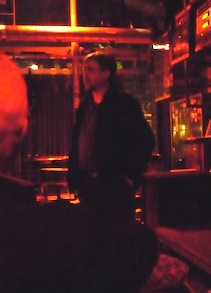 Selected Nebulae consists of a series of short works inspired by images taken by the Hubble and other orbiting telescopes of nebulae in deep space. I have used Kyma to generate these compositions in surround sound, using virtual instruments based on physical models and tuned in just intonation. The video components of these pieces were created by Miranda Raimondi and are based on footage generated with Jitter using many of the same algorithms used to create the pitch and rhythmic patterns of the music. Selected Nebulae consists of a series of short works inspired by images taken by the Hubble and other orbiting telescopes of nebulae in deep space. I have used Kyma to generate these compositions in surround sound, using virtual instruments based on physical models and tuned in just intonation. The video components of these pieces were created by Miranda Raimondi and are based on footage generated with Jitter using many of the same algorithms used to create the pitch and rhythmic patterns of the music.
|
| | Theo Lipfert | Just Below the Surface View Video
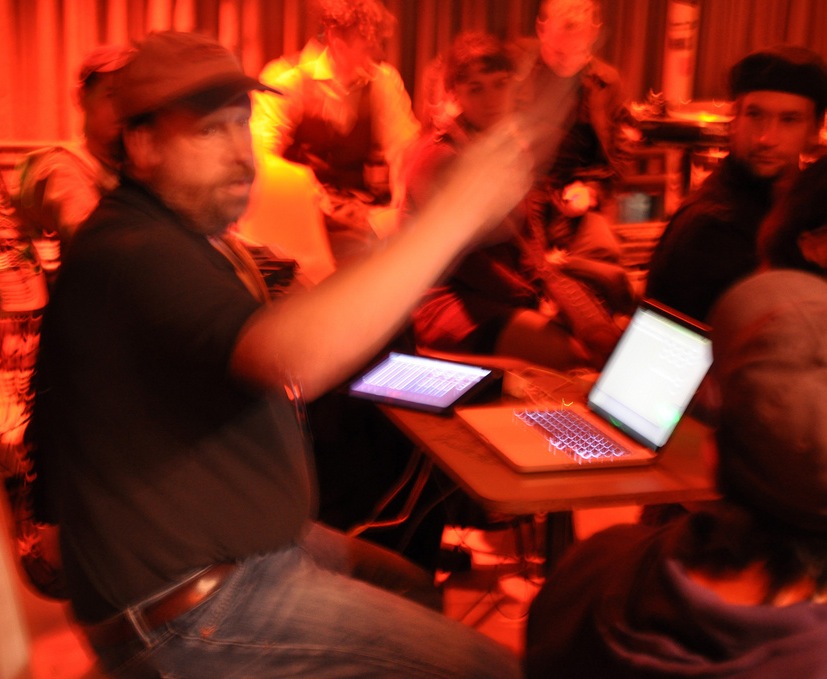 The core elements for the film are audio recordings of children recounting and explaining their dreams. Samples of the children’s recordings are sonically analyzed and processed in combination with sounds that emanate from objects and experiences the children describe. The “actual object” recordings, some more recognizable than others, are produced using a variety of techniques. The result of combining voices with these sounds is a kind of fluid, hypnotic soundscape. The mix suggests a dream-state in which the symbols and signs that we use to navigate the world have been collapsed into a jumble of sonic gestures. The visual component of the film begins as an abstract mix of organic elements, none of which visually describe the audio content. As the film progresses the viewer becomes increasingly aware that they are underneath the surface of the ocean. As the film concludes, a quick cut to recognizable reality signals a sudden awakening. The core elements for the film are audio recordings of children recounting and explaining their dreams. Samples of the children’s recordings are sonically analyzed and processed in combination with sounds that emanate from objects and experiences the children describe. The “actual object” recordings, some more recognizable than others, are produced using a variety of techniques. The result of combining voices with these sounds is a kind of fluid, hypnotic soundscape. The mix suggests a dream-state in which the symbols and signs that we use to navigate the world have been collapsed into a jumble of sonic gestures. The visual component of the film begins as an abstract mix of organic elements, none of which visually describe the audio content. As the film progresses the viewer becomes increasingly aware that they are underneath the surface of the ocean. As the film concludes, a quick cut to recognizable reality signals a sudden awakening.
|
| | Lowell Pickett |  The Pentagon demonstration The Pentagon demonstration
This experiment aims to heighten the audience's awareness of the real and virtual space around them.
|
| | Cristian Vogel | 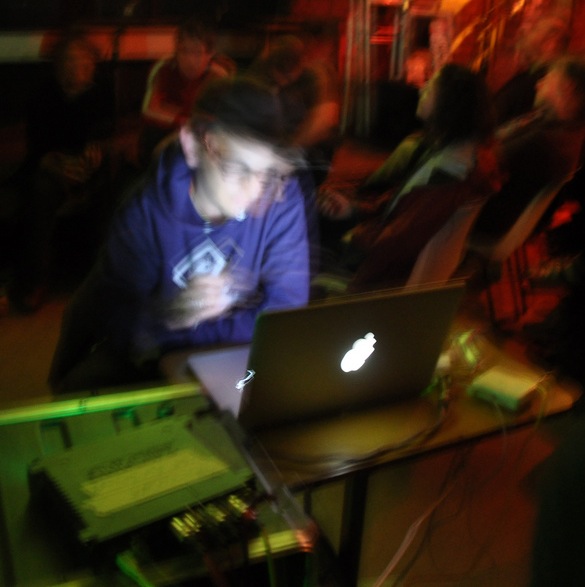 RetroInterrupt RetroInterrupt
A live set by DJ Cristian Vogel with his Kyma NeverEngine and Processing-generated live video.
|
| |